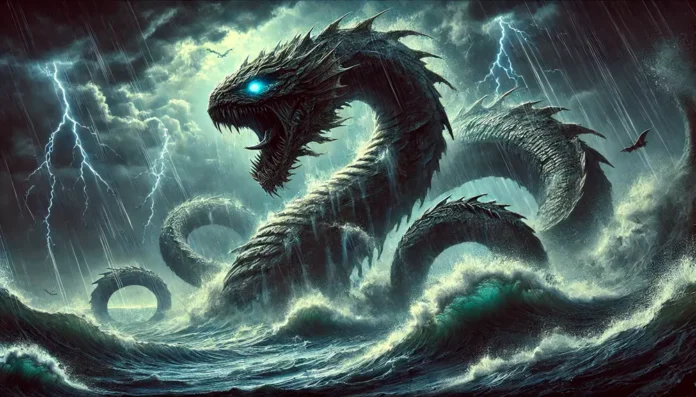Introduction
The Leviathan is a monstrous sea serpent in various mythologies, particularly prominent in Jewish and Christian lore. Depicted as an enormous, destructive creature ruling the depths of the sea, Leviathan often symbolizes chaos and primordial evil.
In Hebrew texts, it is a creature created by God, representing the uncontainable forces of the natural world. From ancient Israelite texts to contemporary literature and media, Leviathan has impacted religious, cultural, and artistic narratives over centuries.
Despite its monstrous nature, it also embodies the vast, mysterious power of the ocean, evoking both fear and respect. Leviathan’s stories and cultural impact continue to serve as reminders of the power of myth in exploring humanity’s relationship with the unknown.
History/Origin
The Leviathan’s origins trace back to ancient Canaanite and Mesopotamian mythologies. In these early stories, it appears as a primordial sea serpent associated with chaos and darkness. One of the first known depictions of a creature resembling Leviathan is found in Ugaritic texts from the Canaanite civilization, where it is called “Lotan,” a multi-headed dragon defeated by the storm god Baal. This battle represents the struggle between order and chaos, with Baal symbolizing the forces of civilization subduing the untamed wild.
In Hebrew scriptures, the Leviathan appears prominently in the Book of Job, Psalms, and Isaiah. Job 41 describes Leviathan in detail as an unstoppable force of nature:
“Out of his mouth go flaming torches; sparks of fire leap forth. Out of his nostrils comes forth smoke, as from a boiling pot and burning rushes. His breath kindles coals, and a flame comes forth from his mouth.” (Job 41:19-21 ESV).
Leviathan is also mentioned in Psalm 74, where God is said to have “crushed the heads of Leviathan” and “gave him as food to the creatures of the desert.” This verse, like others, symbolizes God’s dominion over chaotic forces and serves as a reminder of divine power. As Jewish tradition evolved, Leviathan’s portrayal became more layered. In some rabbinic texts, it is paired with Behemoth and Ziz, other monstrous creatures, which will be slain and served as a feast for the righteous in the world to come.
Name Meaning
The name “Leviathan” derives from the Hebrew “לִוְיָתָן” (Liwyatan), which is often translated as “twisted” or “coiled,” reflecting its serpentine shape. This meaning captures its essence as a convoluted, terrifying presence lurking beneath the sea. In Christian demonology, Leviathan is associated with the sin of envy and is regarded as one of the Seven Princes of Hell, representing a consuming, insatiable desire. Over time, the name “Leviathan” has come to represent anything vast and untamable, further embedding itself in cultural imagination.
Background Story
In Hebrew mythology, Leviathan is a powerful and dangerous creature created by God on the fifth day of creation. According to some interpretations, it was originally part of a pair, with a female Leviathan intended to ensure the species’ survival. However, God is said to have killed the female Leviathan, fearing that their offspring would overwhelm the world. This notion of a male and female Leviathan is present in Midrashic literature, highlighting themes of divine control and the necessity of limiting chaos.
In Canaanite mythology, the struggle between Baal and Lotan reflects a broader Near Eastern motif of the storm god’s victory over the sea dragon. In the Babylonian myth of Tiamat, a similar figure to Leviathan, the god Marduk battles and defeats Tiamat, who personifies the chaos of the primordial ocean. This story likely influenced the Hebrew narrative of Leviathan as a chaotic force subdued by a higher power.
In Islamic tradition, Leviathan is often linked with Bahamut, a giant fish that supports the earth in Islamic cosmology. While the two are distinct, they share a symbolic connection as immense sea creatures embodying the unknowable. The Quran does not mention Leviathan explicitly, but Islamic folklore occasionally references creatures of vast size and power, underscoring the themes of divine order prevailing over chaos.
Leviathan in Comparative Mythology: Tanin and Rahab
Leviathan is often compared to two other mythological sea creatures: Tanin and Rahab. These creatures appear in Hebrew texts and share similarities with Leviathan, embodying aspects of chaos, destruction, and the untamed sea.
Tanin
In Hebrew, “Tanin” refers to sea monsters or serpents, and it is sometimes used interchangeably with Leviathan. The term appears in the Hebrew Bible to describe the serpentine creatures that God creates and subdues. In some interpretations, Tanin represents primal chaos and the threats posed by the sea. While less detailed than Leviathan, Tanin shares its chaotic and monstrous attributes, further illustrating the ancient Israelite conception of the sea as a domain of danger and disorder.
Rahab
Rahab is a mythological sea monster that appears in Jewish, Christian, and Islamic traditions. In the Hebrew Bible, Rahab is mentioned as a force of chaos, symbolizing the tumultuous waters that God overcomes to establish order. Isaiah 51:9 refers to God as having “cut Rahab to pieces,” a symbol of divine victory over chaos. Rabbinic texts expand on Rahab’s story, describing it as a creature of pride that God destroys. Rahab is also depicted as a representation of Egypt in some passages, linking it to human adversaries of Israel.
These creatures reinforce the cultural understanding of the sea as a powerful, mysterious, and often hostile realm. Leviathan, Tanin, and Rahab embody the uncontrollable forces that ancient civilizations associated with the ocean, serving as symbols of chaos that must be overcome by divine power.
Connections with Deities
In addition to Tanin and Rahab, Leviathan is connected to various deities and mythological figures that represent order and chaos:
Yahweh
In Hebrew scriptures, Yahweh is often depicted as the deity who creates, controls, and ultimately destroys Leviathan. This dynamic underscores Yahweh’s supreme authority over the natural world and chaotic forces. The portrayal of Yahweh subduing Leviathan reflects a common Near Eastern mythological theme, where the storm god battles a sea dragon to establish order, paralleling similar stories like Baal’s battle with Lotan.
Baal
The Canaanite god Baal is often seen as Leviathan’s counterpart, battling the sea serpent Lotan in a myth that echoes the struggle between Yahweh and Leviathan. Baal, the god of storms and fertility, represents order and civilization, whereas Lotan symbolizes chaos and the unbridled forces of nature.
Tiamat
The Babylonian goddess Tiamat shares many attributes with Leviathan. Tiamat, like Leviathan, is a primordial ocean entity representing chaos. In Babylonian mythology, she gives birth to sea monsters to challenge the younger gods but is ultimately slain by Marduk, who uses her body to create the heavens and earth. The parallels between Leviathan and Tiamat highlight a widespread cultural motif in which creation arises from the subjugation of chaos.
These comparisons reveal a shared mythological theme across ancient Near Eastern cultures: the belief in a cosmic struggle between order and chaos, represented by gods and sea monsters. Leviathan’s continued relevance in modern culture speaks to the enduring power of these myths and their capacity to address fundamental human concerns about the natural world.
Cultural Impact
Leviathan has had a profound cultural impact across various religious and cultural traditions. In Jewish mysticism, it is a symbol of chaos but also of hidden knowledge. In Kabbalistic teachings, Leviathan represents the primordial chaos that existed before God created the ordered world. This idea has influenced the Zohar, a foundational Kabbalistic text, where Leviathan is portrayed as embodying the forces that must be balanced for creation to be sustained.
In Christian thought, particularly in medieval demonology, Leviathan is associated with the sin of envy and is sometimes depicted as a demon of the waters. Medieval bestiaries, such as The Aberdeen Bestiary, describe Leviathan as a cautionary symbol of sin, warning of the dangers of being consumed by envy or desire. Artistic depictions from this period often portray Leviathan as a dragon or a serpent, emphasizing its terrifying aspect.
Leviathan’s imagery has also influenced art and literature throughout history. In Renaissance art, Leviathan is often depicted as part of the Last Judgment scenes, where it swallows the damned, symbolizing eternal punishment. In literature, its influence is evident in works like Herman Melville’s Moby-Dick, where the white whale embodies Leviathan’s fearsome power and mystery, becoming a metaphor for the unknowable forces of nature.
Religion/Ritual
In Jewish apocalyptic traditions, Leviathan is central to eschatological prophecies, symbolizing the ultimate challenge that God will overcome. During the Messianic age, Leviathan will be slain and served as a feast for the righteous. This meal, often referred to in rabbinic literature, symbolizes the triumph of divine justice over chaos and evil. This narrative has parallels in early Christian eschatology, where Leviathan is seen as an agent of Satan, to be conquered in the end times.
In contemporary Jewish rituals, references to Leviathan occasionally appear during Passover, where it symbolizes divine power and the promise of redemption. In some Sephardic communities, specific prayers and blessings are recited to invoke protection from sea creatures, reflecting an enduring cultural belief in Leviathan’s fearsome nature.
Scientific or Rational Explanations
Many scholars believe that the Leviathan myth was inspired by real marine animals that ancient civilizations encountered, such as whales, giant squids, or crocodiles. In particular, the descriptions of Leviathan’s size, scales, and fiery breath may have originated from exaggerated accounts of whale sightings or volcanic eruptions at sea, which ancient observers might have interpreted as the actions of a colossal beast.
Additionally, some historians suggest that the Leviathan myth may have originated as a metaphor for political or natural chaos. For instance, in Hobbes’ Leviathan, the creature is a metaphor for the state, illustrating how a powerful sovereign is necessary to maintain social order. Leviathan’s association with chaos, therefore, can be understood as an expression of humanity’s fear of disorder, which has historical roots in the uncertainty of the natural world.
In Modern Culture
Leviathan’s influence extends deeply into modern media, symbolizing untamable forces in literature, film, music, and video games. In literature, Thomas Hobbes’ Leviathan explores the idea of a social contract, using the creature as a symbol of the absolute power of the state. In John Milton’s Paradise Lost, Leviathan is described as part of Satan’s forces, representing the destructive potential of rebellion against divine order.
In film and television, Leviathan often appears as a monstrous antagonist. In Supernatural, Leviathan is depicted as an ancient creature that preys on humanity, reinforcing its association with malevolent power. In the Marvel Cinematic Universe, Leviathan is reimagined as massive, whale-like alien creatures serving as weapons of destruction, highlighting its enduring appeal as a symbol of overwhelming strength.
In music, the metal band Mastodon’s album Leviathan explores themes of chaos and the power of nature, drawing inspiration from Moby-Dick. Similarly, in video games like Final Fantasy, Leviathan is a recurring summon monster, embodying the element of water and symbolizing both destructive power and protection. Through these portrayals, Leviathan continues to fascinate as a symbol of the unknown, echoing humanity’s awe of the sea and the mysteries it holds.











